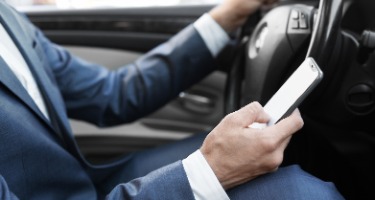You are probably already familiar with Uber, Lyft, and other players in the ride-hailing services space. These companies are similar to many taxi-based services in that they do not own, operate, or control the vehicles used by their drivers, nor do they classify their drivers as employees. In simple terms, drivers contract with these companies to pick up passengers, i.e., the users of their mobile apps. Their customers cannot hail an Uber or Lyft on the street with a fancy whistle or wave. Instead, in this gig economy, they must utilize the app on their phone and arrange for a driver to pick them up and taxi them to their destination.
While these new services have made car travel more convenient, they haven’t made it any safer, and some evidence suggests that they have contributed to more motor vehicle injuries and deaths. According to a study conducted by the University of Chicago’s Booth Business School, motor vehicle fatalities have increased by approximately 3 percent nationwide since 2011—the year in which ride-hailing apps were introduced into most major U.S. cities. But when it comes to litigating car accidents in the gig economy, who exactly is responsible?
As in any car accident or personal injury case, the person pursuing the claim must prove two key things in order to be compensated: liability and damages. Liability centers around who is at fault and damages relates to the claimant’ from the incident. While car accidents (with the passenger as the claimant) are the most common situations in cases involving ride-hailing services, they may also involve incidents such as a driver hitting a pedestrian, running into a bus full of passengers, and other unique conditions.
What Next?
If the negligent party in one of these cases is the driver, the obvious course of action would be to refer the claim to the driver’s personal insurance carrier—similar to the process consumers are familiar with when it comes to car accident claims. But since an Uber or Lyft contractor is driving for money (i.e., a commercial driving service), the situation quickly gets more complicated.
In terms of assessing a case involving one of these drivers, the facts will always be integral to how it progresses, from which insurance carrier is involved to any potential compensation limits. Simply having proof that the driver was at fault is the tip of the iceberg. Key information needs to be verified, such as when the accident occurred; if the driver had already been hired by the ride-hail customer; was an uninsured (or underinsured) driver involved in the accident; and many different aspects that affect how each case is formalized.
Assessing the insurance situation is critical to success in each case. As personal car insurance typically excludes all business use, the driver may not be covered by their policy when they are available for hire but have not yet accepted a ride request, according to the National Association of Insurance Commissioners. If a driver has a commercial policy (or has purchased a ride-hailing “endorsement,” an option in some states) the driver’s personal policy will typically not be a factor. The extra coverage offered by the endorsement may help fill the gaps between the ride-hailing company’s commercial policy and the driver’s personal auto insurance policy.
Uber and Lyft offer liability insurance to their drivers, which will kick in when the driver’s carrier has denied the claim (drivers must submit the claim to their own insurance carriers first). So legal responsibility aside, it is possible to hold a ride-hailing company financially responsible if you are a nonnegligent person in an accident caused by one of their drivers.
Lyft and Uber drivers must carry a commercial policy in order to have passengers in their vehicle. The specific dollar amount available depends on the standing or status of the ride-hailing driver at the time of the accident and based on the following established guidelines:
1) Driver Not Available
If the driver is using their vehicle for personal use and is not available to accept requests for rides from customers, the ride-hailing company’s policy does not apply. Instead, the driver’s personal policy applies. The coverage limit is based on their own personal automobile insurance policy.
2) Available but Not Carrying Passenger(s)
If the driver is available on a mobile app and ready to pick up passengers, but is not actually carrying a passenger when the accident occurs, the primary insurance is the driver’s own policy. However, Uber and Lyft provide additional coverage in this situation with liability up to $50,000 per injury, with a maximum of $100,000, and a maximum of $25,000 in property damage. This coverage only applies if the driver requests coverage from the ride-hailing company and if their own personal liability coverage does not cover all of the damages.
3) Available and Customer-Connected or Carrying Passenger(s)
If the mobile app is turned on and the driver has connected with a potential passenger for pickup or if the driver is on the way to pick up the passenger, then a $1 million insurance policy limit from the ride-hailing company will apply. If the passenger is in the vehicle at the time of the accident, then a $1 million policy will apply. For example, if the driver is carrying a passenger when the accident occurs, the driver and passenger are covered under the liability insurance policy. Additionally, if a third party is injured, such as a pedestrian, they are covered by the company’s policy. However, if the company denies coverage, the driver and passenger may still be denied by the driver’s personal insurance policy because the driver was driving for pay at the time of the accident.
4) Uninsured and Underinsured Motorists
Typically, companies such as Uber and Lyft also carry a $1 million uninsured/underinsured motorist policy so that if an uninsured driver causes the accident this policy will apply.
The company’s insurance carriers will try to avoid paying out as many claims as possible, as this is the nature of the beast. It is not uncommon for accident claims to be denied by the ride-hailing company’s carriers. Another key element that makes these situations more complex is that ride-hailing companies do not consider their drivers to be employees, but rather independent contractors. This distinction has allowed the companies to deny liability when their drivers are involved in accidents. Companies are generally not liable for the actions of independent contractors, as opposed to those of their employees. This makes the process even more complicated for passengers to get compensated when a driver was at fault (e.g., driver was distracted, drunk, or driving recklessly).
One response by accident victims and their attorneys may be to sue the ride-hailing company directly. They may also seek payment from the driver’s personal insurance company. But as many insurance policies prohibit their insured from driving for work purposes or using their car as a taxi or ride-hailing vehicle, suing the driver directly may limit the amount of damages that can be received.
The Dangers of App-Based Driving
It is also important to keep in mind that the success of the ride-hailing model depends on the use of mobile apps—and not just for the consumer. And these mobile applications require inherently risky and potentially negligent behaviors behind the wheel.
Let’s start with how a driver gets a potential customer: When a pickup request comes in, the driver’s smartphone will deliver visual and audio notifications. Next, the driver has seconds (it’s been said that in the case of Uber, 15 seconds) to accept the request. Then the driver must physically tap the screen to accept the “contract.” Ride-hail requests can (and will) be delivered to a driver’s phone at any time—including while the vehicle is moving—meaning that in order for drivers to secure a fare, they must take their hands off the wheel to confirm a pickup.
Not surprisingly, the risky behavior does not stop there. While passengers are in a vehicle, drivers must again turn to their phone—this time for directions. Uber describes its offering as a “redesigned navigation experience built around drivers’ needs.” This “experience” relies on proprietary algorithms that process multiple levels of information in real time (traffic data, road closures, accident reports, weather, etcetera) to deliver the most direct route to the drivers. The bottom line is more and more distractions with the goal of fewer delays, better mileage, and happier customers—since they will arrive at their destination as quickly as possible.
It is important to assess the amount of time and focus that is taken away from the actual act of driving and spent using a smartphone. This is, essentially, time spent not focusing on the road. Research shows that engaging in such behaviors for as little as two seconds can affect a driver’s ability to spot danger—significantly increasing the risk of an accident. At this time, data measuring how much time drivers (of all kinds) spend staring at their phones instead of the road and how that translates into accidents is still lacking.
We do know the obvious—that distracted driving causes accidents, increases the risk of a crash, and ends up killing people. According to the National Highway Traffic Safety Administration, 3,166 people were killed by distracted driving in 2017. Over time, more and more data will continue to help substantiate the statistics. We also know that based on a common sense understanding of the ride-hailing model, more driving will mean one thing: an increase in the number and size of payouts to complainants moving forward.
NHTSA:
https://crashstats.nhtsa.dot.gov/Api/Public/ViewPublication/812700
Daniel Katz is president and founder of RDK Interactive, a full-service technology firm specializing in web and mobile development, business strategy, start-up guidance, and consulting for nearly 30 years. RDK Interactive serves corporate clients such as Comcast, NBC, PBS, and the University of Pennsylvania & The Wharton School plus many law firms such as MOREMARRONE LLC, Dilworth Paxon, Faruqi & Faruqi, GPFF, Willig, Williams & Davidson among others. RDK Interactive's work has won the touted Webby Award along with other industry accolades such as the W3 Gold Award "Recognizing the Power of Web Creativity."
































